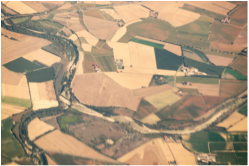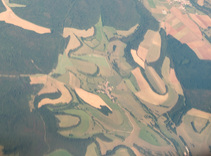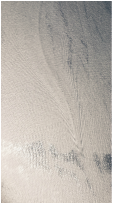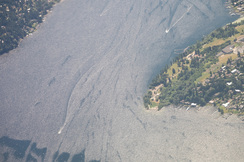|
A vacation in the UK last month included a quick side trip to Italy to see a cousin, not that we need any excuse to visit Italy! The flight from Gatwick to Pisa was over continuous cloud cover, unfortunately, but the return to Heathrow enjoyed perfect weather - at least as far as the English Channel! I could only get a seat behind the wing so the engine exhaust impacted several photos, but here are some I especially liked. More can be found in the Gallery of the Month; as always, click on any image to enlarge it.  This is about as typical an Italian village as you can find! Taken just after take-off from Pisa airport, I love the clusters of red-tiled buildings, and how the straight-edged fields contrast with the winding roads.  After take off we flew up the Western coast of Italy past several small ports; this one had some remarkably white mountains behind it. It turns out that these are the quarries for the world-renowned Carrara marble, used over the centuries for everything from Michelangelo's David to London's Marble Arch and the Peace Monument in Washington, DC.  Further north we passed over the extensive agricultural region of the Po Valley, which runs right up against the Alps. It also includes the industrial areas of Turin and Milan, and the vineyards of Asti!  Clear skies over the Alps gave some stunning views of the mountains. The center peak here is the Matterhorn, as impressive as ever, but while we also saw many glaciers, it was apparent that some were retreating quite rapidly, such as the one in the foreground on La Ruinette.  Heading into southern France I was struck again by the wonderful patterns created by farmers as they cope with the hilly topography and the need to maintain woodland among their fields. And sometimes the patterns seem to form something else, too; once I'd seen the "horns" at the top of these fields, the overall pattern seemed to me to resemble a Cubist's interpretation of a bull!  Where agriculture is king every available piece of land is used, not only where four rivers come together to provide irrigation for the fertile plains, but as far as the eye can see.  Even so, I'm at a loss to explain why there needed to be such a strong diagonal division between these fields! It makes for a striking composition, all the same.
0 Comments
 I'm always on the lookout for airfields as photo subjects when I fly, and on a trip to Phoenix last year spotted one in southern Utah which looked, ah, "adventurous", a mesa-top strip with a very definite "you will be airborne at this point" layout, Turns out this is actually for very good design reasons, because it's not actually an airport. It's a rocket-sled test track used to evaluate ejection seats and other escape capsules, which were triggered at the end of the track and then (hopefully) floated down into the valley 1,500 ft. below. There is a small unpaved runway just off to one side as well. The full story of the track is at: http://www.airfields-freeman.com/UT/Airfields_UT_SW.htm. Fascinating! Seattle to New Orleans in June can be a real study in contrasts, from the cool cloudy Northwest to the steamy sunshine of the South. This trip in late June, however, started in brilliant sunshine in Seattle and ended in New Orleans under stormy skies! As usual, the Gallery of the Month has a wider selection of images from this trip, but here are a few I thought worth commenting on. Click on any one to enlarge it.  In the desert on the eastern side of the Cascades the vivid color of this small lake caught my eye. I'm sure the fact that it's quite close to the nuclear waste storage tanks at Hanford is just a coincidence...  The dry-land farming region north of Walla Walla is a truly fascinating area, with very intriguing patterns of colors and shapes that beg for some kind of explanation. Whatever the reason the result is wonderfully abstract.  The desert can always be relied on to produce some interesting images, and this trip was no exception. Here over western Wyoming the vegetation on the side of a ravine looks like a carnival mask discarded on the desert floor.  Back over agricultural land again, these cultivation patterns and crop/soil colors in eastern Colorado resemble the wood grain patterns of fresh-sawed lumber - somewhat ironic given the total absence of trees in these wide-open plains. It's also interesting to see the different approaches to cultivation in these fields. Some follow (to a greater or lesser degree) the patterns left by earlier contour-based planting, while straight-line fences cut right across others.  Clouds have always fascinated me, and the usual summer thunderstorms on the run into New Orleans didn't disappoint. This massive accumulation on the Texas-Louisiana border just seemed to keep climbing up to the sky, level upon level.  Field patterns often have historical as well as geological significance. Along the Mississippi towards New Orleans land grants were awarded based on a small, uniform length of river frontage to ensure equal access to shipping and irrigation water. The resultant long, thin landholdings thus became very crowded on the inside of the river's many turns! It's been along time coming, but thank you for your patience and welcome to my updated Web site! I've added several new images to the Galleries, have brought the order process back onto the Web site instead of being hosted on ImageKind, and will soon launch a presence on both Instagram and Flickr! As always, I welcome your feedback and comments. The only casualty of the site update was that my old blog posts couldn't be carried forward, but I look forward to sharing my thoughts with you on a much more regular basis, and to hearing back from you soon.
 Despite my official retirement from the hotel technology consulting world last June existing clients kept me traveling through into December, so things didn't feel too different. This year, though, for a variety of reasons I didn't travel anywhere for the first five months. Oddly enough, it was very restful to be at home for an extended stretch, photographing the spring beauty of the Northwest and not feeling any urgent need to get back on a plane! However, a family visit to Burbank, CA in late May called us back to the air, and it did feel good to be back by a window seat again, camera at the ready. Once the initial cloud cover cleared after leaving Seattle plenty of intriguing patterns and images once again presented themselves. The current Gallery of the Month shows all the main images I took, but here are a few I thought worth commenting on. (As always, click on any image to enlarge it.) The colors of Shasta Lake around Bridge Bay Resort were especially striking, and it was good to see the water level higher than it's been in a while!  A little further south the agricultural fields in the Central Valley formed their usual fascinating abstracts. I was particularly taken with the angles in this one; even the cultivation of individual rows in some of the fields seems to start and stop on sharp diagonals!  One field in particular had a pattern I've not seen before, looking like some kind of traditional Southwest blanket design. Given the apparent flat nature of the surrounding fields I can't begin to imagine what combination of farming, irrigation and terrain produces this effect, but it was very pretty.  On the return trip a residential development construction site caught my eye, with its intriguingly complex and rhythmic pattern of roads, tiered building sites and colors.  Here's another intriguing farm image, this one near Bakersfield. I doubt if the white buildings at the top were laid out with this in mind but it certainly looked to me like a painting of a Greek temple, complete with columns and entrance portico!  This farm showed a most unusual effect. The cultivated fields appear to be uniformly flat and even, laid out like a massive sheet of cardboard on top of and completely separate from the underlying arid desert soil with its multiple streambeds and gullies. Looking closely you can see traces of the terrain showing through the crops, but the illusion is striking..  Finally, before the clouds of the Northwest rolled in and cut off the view, I was struck by the brilliant blue of Millerton Lake (near Fresno) snaking through stark, bare hills on the western fringe of the Sierras. Coming from England I'm still not accustomed to seeing lakes of this size in such barren surroundings, completely devoid of vegetation. Makes me wonder how long it takes for nature to work its magic, breaking down the rock into soil and slowly spreading plant life up from the water's edge. Probably quite a while... |
AuthorJon Inge writes about his travels and the sights that have caught his eye. Archives
November 2018
Categories |





 RSS Feed
RSS Feed
